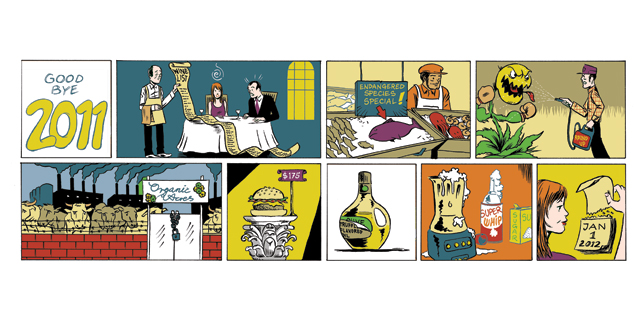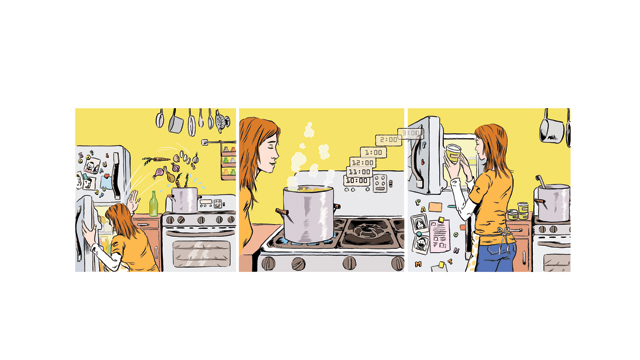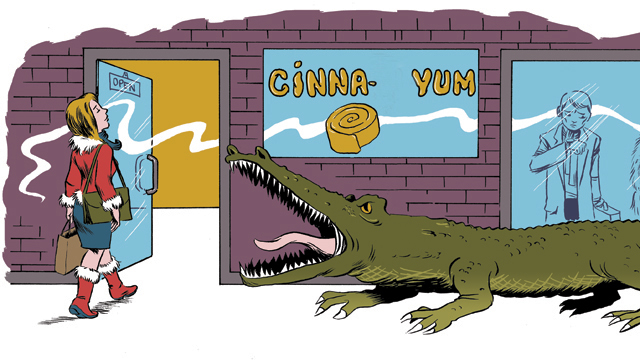Change, as the bumper sticker says, is guaranteed. Sometimes, however, it can be hard to see before it’s come and gone.
Nowhere is this more true than in our oceans, where, unless you’re a marine biologist or a fisherman, you may not have had any reason to notice the various catastrophes evolving. The bluefin tuna, that darling of luxury sushi bars, for instance, is so drastically, critically endangered at this point that there are fewer wild southern bluefin tuna than there are wild tigers. (I think the day will come when our grandkids hear about our eating bluefin sushi with the same horror with which we read of British explorers bringing home stacks of tiger-skin rugs.)
Some 90 million tons of seafood is taken out of the wild oceans every year — nearly five times what was taken before World War II, according to a U.N. report. And the ocean doesn’t have that quantity to give. In 2006, a group of international scientists released a report saying that by 2048 wild seafood will essentially be gone. By way of a response, the international fishing industry, which at least seems to see the writing on the wall, has invested massively in aquaculture, which essentially involves raising fish in self-contained, highly controlled systems. Some experts predict that, in 2013, for the first time, people will have consumed nearly as many farmed fish as they did wild. Unfortunately, due to lax regulations, a percentage of these farmed fish morph into coastal polluters, spreading disease to wild sea life and further darkening the future of the seas.
But how would anyone on a tread-mill in Ohio, at a playground in Phoenix, or at dinner in Atlanta know anything about these trends? The overall picture is rarely broken down in a headline, and too often the parties with the most invested in the situation are also the most likely to stay silent on the subject.
Those of us who do know how dire things have become, however, are now in that unenviable place where we must weigh our desire for a good and tasty life against the needs of the future. How do we set our priorities? How can we help each other better understand the situation and act accordingly? And, finally (perhaps most importantly), what the heck can we actually eat?
Don’t Despair
There’s a lot of bad news out there, and your first thought may be, Fine, I just won’t eat fish. I’ll shift to French fries (made from potatoes grown on a small organic farm!). As tempting, and as comforting, as this might seem, don’t let yourself off the hook so easily.
The only way the health of the oceans will improve is for consumers to put pressure on the system itself. Use your buying power to help influence the tens of thousands of tiny decisions made during the production, distribution, and sale of your seafood.
Get the Facts
The species making up “seafood” number in the tens of thousands. They are caught in different ways, in different seas, and they emerge from fisheries in sometimes changing states of health and varying stages of scientific understanding. If that weren’t enough reason for the average consumer to run screaming for the meat counter, by the time fish reach individual consumers, they’re often meaninglessly rebranded. (Last February, a group called Oceana did a genetic survey and found that a third of fish in New York City–area stores was mislabeled, such as bream for grouper, tilefish for halibut.)
In fact, local populations of fish, which have widely divergent characteristics, often share the same broad names. Just try to count how many different species are called “rockfish.” Is it a California scorpionfish, a Maryland striped bass, an Oregon black rockfish, a China cod, endangered, abundant, or sitting in the grocery store mislabeled as “snapper”? Who knows. One option would be to hire a stand-by marine biologist and set aside $10,000 a year for genetic tests of appealing-looking fish fillets. Another option is to know who possesses the best information and how to access it efficiently.
Several third parties evaluate fisheries, including the Marine Stewardship Council and the Monterey Bay Aquarium. Download the free Seafood Watch app from the Monterey Bay Aquarium and you can evaluate menu items in the moment. Even better, the Seafood Watch app connects to a smartphone map that documents sustainable restaurants all over the country — those big-volume buyers that make the real difference supporting good fishermen and businesspeople.
Buy American
The United States actually has some of the best fishery management in the world, due in large part to the 1996 Sustainable Fisheries Act.
The state of Alaska, which began aggressively managing its fisheries for sustainability in the early 1970s, has developed a fish-management system that relies on constant monitoring. This helps ensure that there are always enough juvenile fish to provide the desired number of future grown-up fish. This sort of thing sounds like a no-brainer to the landlubber, but getting fishermen to trust scientists enough to stop fishing when they say stop is actually a historically enormous feat.
New England lobstermen are learning both from Alaska’s successes and from failures closer to home. (Canada closed its depleted cod fishery in 1992, and the population hasn’t bounced back yet. The Gulf of Maine, an Indiana-size area in the Atlantic near New England, is facing similar doom.) Banding together in a campaign of self-governance, New Englanders have not only seen the depth and quality of their lobster catches boom, the Marine Stewardship Council has dubbed Maine’s fishery sustainable. Lobster rolls for all!
Domestically raised tilapia has also emerged as a healthy option. This might have been foretold in the Bible; some scholars think the miracle of the loaves and fishes was about tilapia, a fish that originally hails from Egypt’s Nile River. Mainly, though, the fish is remarkable for its ability to live on vegetarian feed, including grain and vegetable peelings.
Today, tilapia is being raised willy-nilly all over the place: in massive warehouses without a single drop of wastewater, in small aquaponic systems in restaurants, and even in the basements of survivalists.
Finally, consider the oyster — and the mussel. Almost all of the North American stars of the oyster bar are farmed by fishermen who have devised a way to get oyster or mussel “seed” (baby oysters or mussels) to grow on a structure they provide, such as a net or a cage. These oysters and mussels live on algae and plankton, and as they eat them they clean the ocean. (In some coastal places, the small plants in the ocean are growing too numerously because of fertilizer runoff; oysters and mussels keep this problem in check.)
Shellfish farmers are on the ocean every day. They see poachers, they call out illegal dumpers, and they’re not shy about raising a stink when municipalities want to discharge sewage into the ocean.
So while a plate of French fries may not be the ethical dish we need for a changed world, moule frites, that Belgian preparation of a giant mound of mussels with fries on the side, may be just the sort of thing we get to enjoy when we set priorities for the waters we live off of, for real and for good.




This Post Has 0 Comments